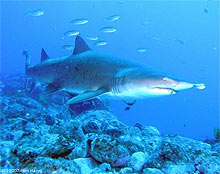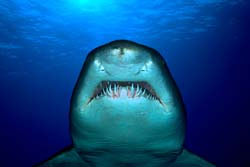The Grey Nurse Shark (Carcharias taurus)
Grey Nurse Sharks are arguably our most deceptive species of shark. With their protruding rows of teeth and their massive size, they have invoked fear in the hearts of many. Fortunately for us, they’re actually one of the more gentle giants of the shark world.
The Grey Nurse Shark (Carcharias taurus) has a large, stout body, with a distinctive hump-shape on its back. It has a grey or reddish-brown back, sometimes with darker spots, and a pale underbelly. This powerful-looking shark is a slow but strong swimmer, and is generally found hovering above the seafloor of sandy-bottomed gutters or rocky caves.
|

Image courtesy Ron Henry |
The waters off Eastern Australia, from Southern Queensland to Southern New South Wales, are home to an isolated population of Grey Nurse Sharks. This population (called the NSW population) of less than 500 individuals is critically endangered. Adding to their vulnerability, at any one time, a large portion of the population can be seen aggregating in one area. Without intervention and significant protection, this population is predicted to reach quasi-extinction (less than 50 females) in less than 10 years. This is the “point of no return” for the population, and means these animals will become extinct within our lifetime.
Due to their unusual breeding habits, the Grey Nurse Shark population recovery rate is among the lowest of all shark species. Each female shark has two uteri, and many eggs are released into each at the start of the reproductive cycle. But when the embryos hatch as pups, they begin to eat each other in a process known as ‘intra-uterine cannibalism’. This is literally ‘survival of the fittest at work’, but it means that each female Grey Nurse Shark produces only two pups every two years. Unfortunately, this slow reproductive rate cannot account for the number of Grey Nurse Sharks accidentally killed by humans each year.
 |
Grey Nurse Sharks are top predators of the marine ecosystems off Eastern Australia. Their extinction would likely lead to a series of events such as a significant increase in baitfish and smaller sharks and rays (which Grey Nurse Sharks feed on), causing a subsequent decline or extinction of smaller marine animals (the next step down the food chain). Interrupting ecosystem balance is dangerous, and will no doubt bring about significant unpredictable impacts on larger marine ecosystems, and on all of us who rely on resources from the ocean.
There are a number of large-scale attempts to protect our local population of Grey Nurse Sharks from extinction. These include research being done by the NSW Department of Primary Industries to breed shark pups in artificial uteri, and legal battles for wider and more stringent protected areas for these sharks.
|
There are a number of things each of us can do to help protect our local population of Grey Nurse Sharks from extinction. The 2002 Commonwealth Government Recovery Plan for Grey Nurse Sharks lists four key threats to our Grey Nurse Sharks. We can each help Grey Nurse Sharks by addressing these threats.
To reduce the number of sharks digesting discarded hooks, if you ever see fishing line or hooks that have been left behind on the shore, carefully pick them up and put them in the bin. In addition, if you ever see a recreational or commercial fishing boat that you think may be impacting a Grey Nurse Shark area, report it to authorities immediately.
SCUBA diving is a fantastic way to develop an understanding of the other world beyond our shores. Diving with Grey Nurse Sharks is also an inspiring experience. However, these activities may affect the behaviour of Grey Nurse Sharks, and must be monitored and managed effectively.
|

Image courtesy Ron Henry |
Many Grey Nurse Sharks (and other non-target species) are caught in shark nets along the NSW coast each year. The idea of shark nets is not to stop sharks coming in to the beaches, but to intercept and catch them on their regular feeding and territorial runs. There are currently a total of 49 meshed beaches along approximately 200 km of coastline between Newcastle and Wollongong in New South Wales. We need to accept the risk we are taking while swimming in the ocean, and encourage policy-makers to use alternative shark-repellant devices if necessary.
The huge demand for shark fins overseas often results in illegal finning of sharks, including Grey Nurse Sharks. Never eat or purchase anything associated with shark fins.
download as pdf
|
|




